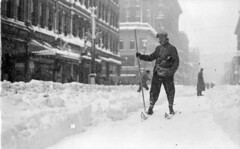You just never know what you are going to get with the weather in Denver and we see that in our look back at the Denver weather history books. From cold and snow to damaging winds and spring-like temperatures, we can and do see it all.
From the National Weather Service:
26-1
In 1888…a protracted warm spell lasted a week. Maximum temperatures ranged from 62 degrees on the 29th to an all time record high for the month of 76 degrees on the 27th. Daily record high temperatures of 76…69…and 71 occurred on the 27th…28th…and 30th respectively. Record high minimum temperatures of 47 and 34 occurred on the 26th and 27th.
27-28
In 1899…snowfall totaled 6.2 inches in the city. Northeast winds were sustained to 36 mph with gusts to 40 mph on the 28th.
In 1965…high winds raked the Front Range foothills. West winds gusted to 89 mph on Table Mountain in Boulder…87 mph at Rocky Flats…and 54 mph at Stapleton International Airport. Damage and minor injuries occurred in Boulder and western metro Denver. Four men were injured by wind-caused accidents while working on construction…2 in Denver and 2 in Boulder. There was extensive damage to power lines… Buildings…signs…and trees. Some minor accidents were caused by blowing dust and debris. Blown dust accumulated 2 to 3 feet deep on some lawns in northern metro Denver suburbs. Dust blew into buildings and homes.
In 1989…the heaviest snowstorm of the winter dumped 9 to 15 inches of snow across metro Denver. Snowfall totaled 8.8 inches at Stapleton International Airport with most of the snow…8.6 inches…falling on the 28th. Strong north winds gusting to 46 mph whipped the snow into 2-foot drifts and reduced visibility in blowing snow. The foothills received up to 18 inches of snow. The snow fell on a weekend…so closures and other disruptions were minimal. The public reported thunder in Arvada…Wheat Ridge…and Boulder on the evening of the 27th. A thunderstorm produced snow pellets at Stapleton International Airport during the early morning hours of the 28th. This was the first thunderstorm in the city during January since 1932.
In 1996…winds to hurricane force were reported across the Front Range foothills in the wake of a pacific storm system. Recorded wind speeds included: 86 mph at the National Center for Atmospheric Research southwest of Boulder…86 mph atop Squaw Mountain west of Denver…and 75 mph at Jefferson County Airport in Broomfield. West-northwest winds gusted to 48 mph at Denver International Airport on the 28th.
In 2009…high winds buffeted the foothills of Boulder and Jefferson counties. Peak wind gusts included: 101 mph at Eldora Ski Resort…100 mph…6 miles northwest of Boulder; 84 mph at NCAR Mesa Lab…79 mph…5 miles northwest of Boulder; and 75 mph at the National Wind Technology Center. In Nederland…a wind turbine recently installed was damaged by the high winds. A peak wind gust of 38 mph occurred at Denver International Airport on the 28th.
27-31
In 1951…a major storm dumped 10.1 inches of snowfall at Stapleton Airport. Most of the snow…8.3 inches…fell on the 29th. Cold arctic air accompanied the snow. Several temperature records were set…including record low maximum temperatures of 4 on the 28th and 4 below zero on the 29th and record low temperatures of 12 below zero on the 29th and 24 below zero on the 31st. Temperatures were below zero for 45 consecutive hours.
28
In 1872…the low temperature dipped to 22 degrees below zero… A record minimum for the date.
In 1909…gale force north winds were sustained to 45 mph behind an apparent cold front…which also produced a trace of snow.
In 1986…a wind gust to 67 mph was recorded in Boulder. West winds gusted to 41 mph at Stapleton International Airport.
28-29
In 1956…snowfall totaled 5.5 inches at Stapleton Airport where east winds gusted to 32 mph on the 28th.
In 1972…cold west winds buffeted Boulder. A wind gust to 92 mph was recorded at the National Bureau of Standards…while a gust to 76 mph was measured in downtown Boulder. Two mobile homes were overturned in Boulder. Other damage was minor. Northwest winds gusted to 40 mph at Stapleton International Airport on the 28th.
In 1987…strong winds buffeted the Front Range foothills and spread east over the plains. The highest wind recorded was 99 mph on the 29th at both the National Center for Atmospheric Research in Boulder and the Rocky Flats plant south of Boulder. Wind gusts in excess of 80 mph were common. A northwest wind gust to 54 mph was recorded at Stapleton International Airport on the 28th with a gust to 41 mph on the 29th. Planes were damaged at both the Boulder and Jefferson County Airports. Hangars were also damaged at Jefferson County Airport. Many windows were broken…signs toppled…and trees downed. A brick wall was blown onto parked cars in Lakewood. A couple of houses in Lakewood were unroofed…while falling trees damaged others. Two people were injured by flying debris in Lakewood and Golden. Total insured damage along the Front Range was 10 million dollars making the wind storm the second most costly on record in Colorado at the time.
In 1995…deepening upslope winds along the eastern foothills on the 28th gave way to periods of heavy snow during the night and early morning hours of the 29th. Snow fell to a depth of 8 inches in both Golden and Boulder with up to a foot in the foothills. Only 1.9 inches of snow fell at Stapleton International Airport…where east winds gusted to 22 mph on the 28th.
In 2001…heavy snow fell across metro Denver. The heaviest snowfall occurred from just south of Denver to around Castle Rock. Snow amounts included: 12 inches east of Parker…9 inches near Elizabeth and in Littleton…8 inches near Castle Rock and in Parker…and 7 inches in Aurora. Snowfall totaled 6.0 inches at the site of the former Stapleton International Airport.
28-30
In 1887…winds were strong and gusty for three days in the city. West and northwest winds were sustained to 56 mph on both the 28th and 29th and to 44 mph on the 30th. Temperatures warmed to a high of 57 degrees on the 29th.
29
In 1900…northwest winds were sustained to 45 mph with an extreme velocity of 46 mph.
In 1914…this was the last day of 60 consecutive days with snow cover of one inch or more in Denver. This third longest period of snow cover on record began with the record breaking snow and blizzard on December 1-5… 1913 when a total of 45.7 inches of snow fell in downtown Denver. Additional snowfall during December and January prolonged the event. Snow depth on the ground to the nearest tenth of an inch was measured once daily at 6:00 pm MST.
In 1927…west winds were sustained at 40 mph with gusts to 42 mph.
In 1942…heavy snowfall totaled 6.2 inches in downtown Denver. North winds were sustained to 17 mph.
In 1965…strong winds occurred in Boulder for the third consecutive day. Only limited minor damage was reported. Northwest winds gusted to 40 mph at Stapleton International Airport.
In 1984…highs winds in and near the foothills produced wind gusts as high as 71 mph in Boulder. A plane was flipped over at Jefferson County Airport and damaged beyond repair. In Lakewood…two construction trailers were damaged by the gusts. North winds gusted to only 38 mph at Stapleton International Airport.
In 1990…gale to hurricane force winds gusts raked the foothills. Wind gusts of 50 to 90 mph were common in Boulder County. A peak wind of 94 mph was clocked at Table Mesa in southwest Boulder. Scattered power outages and minor property damage were reported. West winds gusted to 46 mph at Stapleton International Airport.
29-30
In 1985…an arctic air mass with snow closed I-70 for a time in Denver and east of Denver. Snowfall totaled 5.4 inches at Stapleton International Airport where north winds gusted to 29 mph on the 29th.
29-31
In 1883…a major winter storm dumped 19.3 inches of snow on downtown Denver. Most of the snow…12.2 inches…fell on the 31st. This was the heaviest snowfall to hit the city in years. Temperatures plunged from a high of 52 degrees on the 29th to a low of 13 degrees on the 31st. Precipitation from the storm totaled 2.23 inches. The 1.22 inches of precipitation on the 31st was the greatest calendar day and 24 hour precipitation ever recorded in the city during the month of January.
Continue reading January 28 to February 3: This week in Denver weather history





